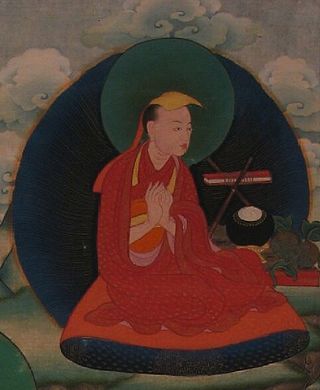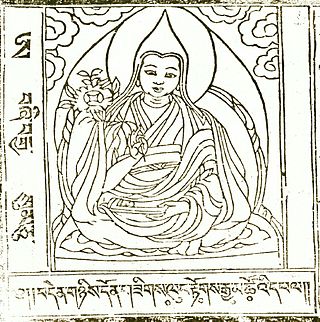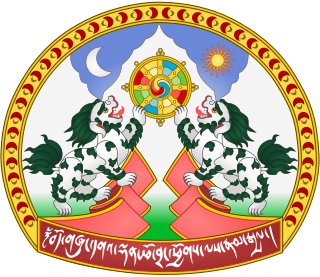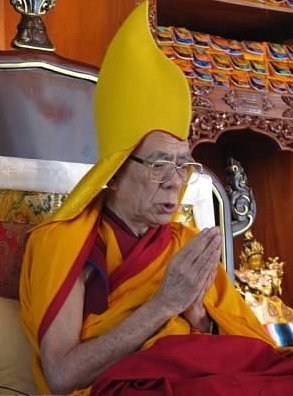Related Research Articles

The Gelug is the newest of the four major schools of Tibetan Buddhism. It was founded by Je Tsongkhapa (1357–1419), a Tibetan philosopher, tantric yogi and lama and further expanded and developed by his disciples.

The Ganden Tripa, also spelled Gaden Tripa, is the title of the spiritual leader of the Gelug school of Tibetan Buddhism, the school that controlled central Tibet from the mid-17th century until the 1950s. The 103rd Ganden Tripa, Jetsun Lobsang Tenzin died in office on 21 April 2017. Currently, Jangtse Choejey Kyabje Jetsun Lobsang Tenzin Palsangpo is the 104th Ganden Tripa.

Lungtok Gyatso, shortened from Lobzang Tenpai Wangchuk Lungtok Gyatso, was the 9th Dalai Lama of Tibet. He was the only Dalai Lama to die in childhood and was first of a string of four Dalai Lamas to die before reaching 22 years of age.

Ganden Monastery or Ganden Namgyeling or Monastery of Gahlden is one of the "great three" Gelug university monasteries of Tibet. It is in Dagzê County, Lhasa. The other two are Sera Monastery and Drepung Monastery. Ganden Monastery was founded in 1409 by Je Tsongkhapa Lozang-dragpa, founder of the Gelug order. The monastery was destroyed after 1959, but has since been partially rebuilt. Another monastery with the same name and tradition was established in Southern India in 1966 by Tibetan exiles.

Drepung Monastery, located at the foot of Mount Gephel, is one of the "great three" Gelug university gompas (monasteries) of Tibet. The other two are Ganden Monastery and Sera Monastery.

Kumbum Monastery, also called Ta'er Temple, is a Tibetan gompa in Lusar, Huangzhong County, Xining, Qinghai, China. It was founded in 1583 in a narrow valley close to the village of Lusar in the historical Tibetan region of Amdo. Its superior monastery is Drepung Monastery, immediately to the west of Lhasa. It is ranked in importance as second only to Lhasa.

The Emblem of Tibet is a symbol of the Tibetan government in exile. It combines several elements of the flag of Tibet, with slightly different artistry, and contains many Buddhist symbols. Its primary elements are the sun and moon above the Himalayas, which represent Tibet, often known as the Land Surrounded by Snow Mountains. On the slopes of the mountains stand a pair of snow lions. Held between the two lions is the eight-spoked Dharmacakra, represent the Noble Eightfold Path of Buddhism. Inside the wheel, the three-colored swirling jewel represents the practices of the ten exalted virtues and the 16 humane modes of conduct. The inscription on the swirling banner below is as follows: bod gzhung dga' ldan pho brang phyogs las rnam rgyal The Ganden Palace, located in Drepung monastery was the residence of the Dalai Lamas until the 5th Dalai Lama. After the 5th Dalai Lama had moved to the Potala in the mid 17th century the Tibetan Government created by him in 1642 became known as the "Ganden Phodrang" Government.

Zong Rinpoche was a Gelug Lama and disciple of the third Trijang Rinpoche, junior tutor of the 14th Dalai Lama. He was famous as a sharp analyst and master of philosophical debate, as well as a powerful Tantric practitioner. He was the Abbot of Ganden Shartse monastery.

Trülku Drakpa Gyeltsen (1619–1656) was an important Gelugpa lama and a contemporary of the 5th Dalai Lama (1617–1682). His Seat was the upper residence of Drepung Monastery, a famous Gelug gompa located near Lhasa.

Sönam Rapten, initially known as Gyalé Chödze and later on as Sönam Chöpel, was born in the Tholung valley in the Central Tibetan province of Ü. He started off as a monk-administrator of the Ganden Phodrang, the early Dalai Lamas' residence at Drepung Monastery, outside Lhasa, Tibet. From around or before the age of 20 he became the Treasurer and the "Chagdzo" of the Fourth (1589-1617) and, subsequently, the Fifth Dalai Lama (1617-1682). He presided as the most senior official of the Gelugpa school of Tibetan Buddhism for over 40 years.

Kyabje Yongzin Ling Rinpoche is a Tibetan tulku. The best-known incarnation is the sixth incarnation, Thupten Lungtok Namgyal Thinley, a Tibetan buddhist scholar and teacher.
Panchen Sonam Dragpa (1478–1554) was the fifteenth Ganden Tripa or throneholder of Ganden Monastery. His texts form the core curriculum for the Loseling College of Drepung Monastic University, the Shartse College of the Ganden Monastic University, and several other Gelugpa monasteries. He was taught by the second Dalai Lama, and in turn later became the teacher of the third Dalai Lama.
Shalu Lochen Legpa Gyaltsen (1375–1450) was a Tibetan spiritual leader. He was the fourth Ganden Tripa of the Gelug school of Tibetan Buddhism from 1438 to 1450.
Chökyi Gyeltshen (1402–1473) was a Tibetan spiritual leader. He was the sixth Ganden Tripa of the Gelug school of Tibetan Buddhism from 1463 to 1473. He was also the 1st Tatsak Rinpoche.
Mönlam Legpa Lodrö (1402–1476) was a Tibetan spiritual leader. He was the eighth Ganden Tripa of the Gelug school of Tibetan Buddhism from 1480 to 1489.

The Ganden Phodrang or Ganden Podrang was the Tibetan system of government established by the 5th Dalai Lama in 1642; it operated in Tibet until the 1950s. Lhasa became the capital of Tibet again early in this period, after the Oirat lord Güshi Khan conferred all temporal power on the 5th Dalai Lama in a ceremony in Shigatse in 1642. The Ganden Phodrang accepted China's Qing emperors as overlords after 1720, and the Qing became increasingly active in governing Tibet starting in the early 18th century. After the fall of the Qing empire in 1912, the Ganden Phodrang government lasted until the 1950s, when the People's Republic of China (PRC) invaded Tibet. During most of the time from the early Qing period until the end of Ganden Phodrang rule, a governing council known as the Kashag operated as the highest authority in the Ganden Phodrang administration.

Yeshe Lobsang Tenpai Gonpo was the 8th Tatsag, a Tibetan reincarnation lineage. From 1789 to 1790 and from 1791 until his death in 1810 he was regent of Tibet, appointed by the Qing dynasty of China. He was the first owner of the Kundeling Monastery, founded in 1794 in Lhasa.

The Tatsag or Tatsak lineage is a Tibetan Buddhist reincarnation lineage whose first member was Baso Chokyi Gyaltsen (1402–73). Since 1794 the Tatsag has been the owner of the Kundeling Monastery in Lhasa. There has been some controversy over the representative of the lineage in recent years.
Kelden Gyatso (1607-1677) was a 17th-century Tibetan poet, scholar, and siddha. He was the first of the Rongwo Drubchen tulku lineage, and an important figure for Buddhism in Amdo, a region of north-eastern Tibet. The founder of a religious college and a seminary for tantric studies in Rebgong, throughout his life Kelden struggled between his desire to become a recluse hermit and his responsibility to these institutions. While he was ordained and taught in the Gelug school, he had a special affinity for Milarepa, the legendary Tibetan poet of the Kagyu school. The information that survives about Kelden comes from a biography by Jangchup Mila Ngawang Sönam (1636-1716), and from his poetry and songs, both written down and performed today by monks in Amdo.

Rizong Sras Rinpoche, spiritual name Thubten Nyima Lungtok Tenzin Norbu, was an Indian cleric from Ladakh who was the 102nd Ganden Tripa - finally titled as Ganden TrisurRizong Sras Rinpoche. Prior to becoming the Ganden Tripa, he was the Jangtse Chöje Rinpoche from Gyüme Tantric College.
References
- ↑ "Ganden Tripa", Wikipedia, 2022-08-11, retrieved 2022-11-02
- ↑ "BUDA - Buddhist Digital Archives". library.bdrc.io. Retrieved 2022-11-02.
- ↑ Chhosphel, Samten. "The Fortieth Ganden Tripa, Pelden Gyeltsen". The Treasury of Lives. Retrieved 2022-11-02.